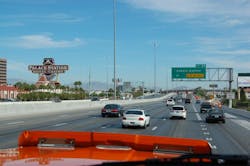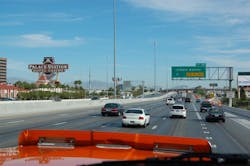But now Ford Motor Co. is taking a fresh look at how space-based communication relays might help earthbound vehicles better navigate traffic congestion, or more importantly get an SOS out quick in case something bad happens.
Those are just some of the aspects being explored by Ford via a three-year research partnership with the telematics department of St. Petersburg Polytechnic University in Russia – an academic institution closely bound to that nation’s space industry that (perhaps unfortunately for us Americans) seems to be rapidly supplanting the U.S. when it comes to orbital research endeavors.
The reason behind the growing interest in such “protocols” is that they offer the potential to reduce traffic accidents and ease congestion by enabling vehicles to communicate with each other, and to communicate with buildings, traffic lights, the “cloud” and other systems to deliver a message or detect and respond to imminent collision warnings, according to Paul Mascarenas (at right), Ford’s chief technical officer and VP of its research arm.
The biggest “advancement” of this collaborative work to his mind is in emergency vehicle communication methods. “We’re analyzing how emergency messages should be sent to ensure delivery if network failures were to occur, identifying the systems and methods that provide redundancy in case of primary delivery failure,” Mascarenas noted.
For example, if an accident were to cause vehicle-to-cloud communications (V2C) to be broken, a vehicle may still have access to a vehicle-to-vehicle (V2V) communications network. Thus an emergency signal message could potentially be sent through V2V to a vehicle nearby, and then between vehicles and infrastructures until it reached emergency medical service (EMS) responders.“The research of fallback options and robust message networks is important,” added Oleg Gusikhin (at left), technical leader in systems analytics for Ford. “If one network is down, alternatives need to be identified and strengthened to reliably propagate messages between networks.”
Then there’s the potential of “space telematics” developed for use on space stations to potentially boost the reliability of future vehicle-to-cloud, vehicle-to-infrastructure, vehicle-to-vehicle and other such communication pathways, Gusikhin said.
That would result in a “blend” of multiple networking technologies, including dedicated short-range communication (DSRC), cellular LTE wireless broadband and mesh networking to ensure robust and reliable connectivity for optimum signal strength for critical messages, he noted.
Thus, using the knowledge accrued from analyzing the space robots, Ford engineers could then develop an algorithm that is integrated into the V2X system resulting in a message that would route through the appropriate network depending on the level of its importance, Gusikhin explained.
For example, an emergency message could be communicated through the faster “mesh” network, whereas an entertainment-related message would route through a vehicle-to-infrastructure application, an embedded device or a brought-in device network.
“We are analyzing the data to research which networks are the most robust and reliable for certain types of messages, as well as fallback options if networks were to fail in a particular scenario,” Gusikhin stressed. “In a crash, for example, a vehicle could have the option to communicate an emergency though a DSRC, LTE or a mesh network based on the type of signal, speed and robustness required to reach emergency responders as quickly as possible.”
And more rapid communication of such events could help a lot of lives in the long run one hopes at least.



